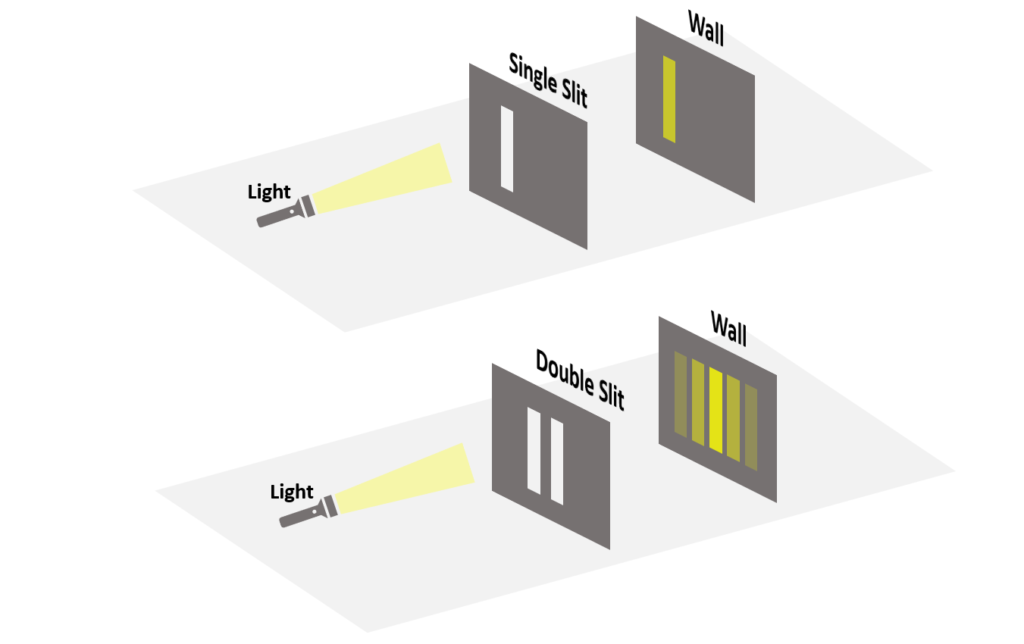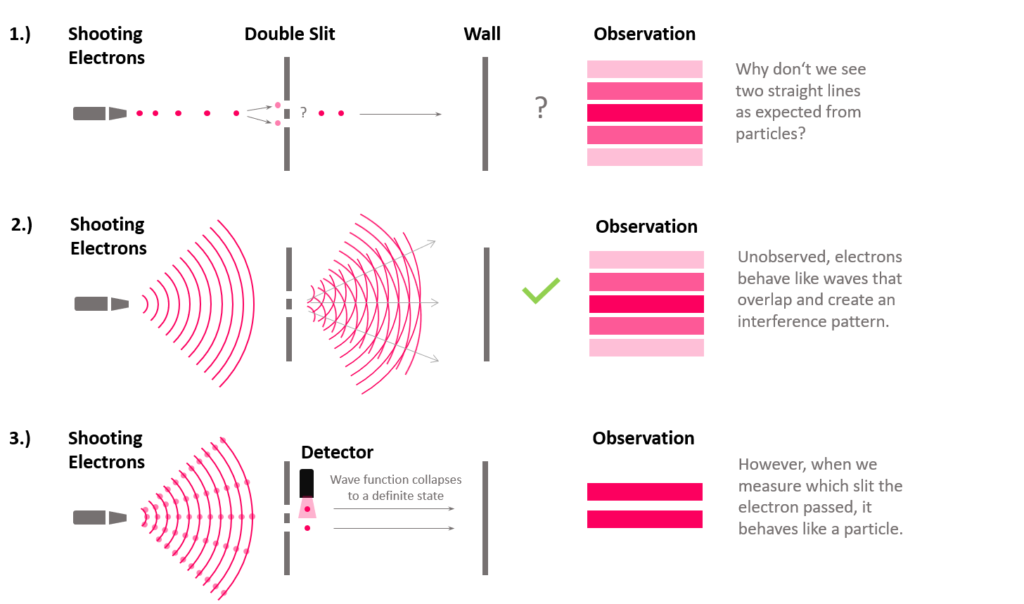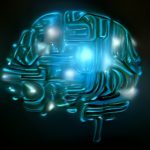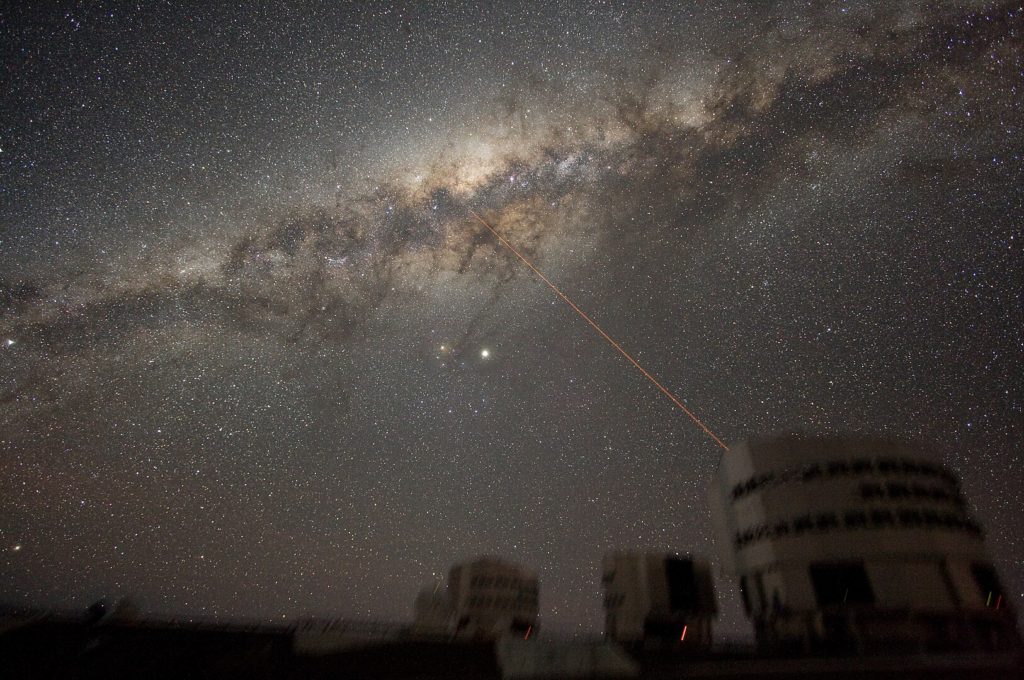The mysterious double-slit experiment exposes the shocking nature of quantum physics and turns our worldview upside down. From the basic setup to extended variations and scary interpretations, this article covers everything from A-Z you need to know about the double-slit experiment.
Whether you are a physics student or just curious about quantum mechanics after you accidentally clicked on this blog, we guide you through the most beautiful experiment ever conducted and simplify its strange results for you. We’ll explore how this is related to time travel, why your future might already be determined, and why we may live in a simulation. In any case, you will have a different view of the world at the end.
The Basic Double-Slit Experiment
There are 3 things required for the basic setup of the double-slit experiment. A light, a surface such as a wall or a screen, and obviously a double-slit in between through which the light passes to reach the surface. If you turn on the light and close one of the slits, you can observe (surprise) a strip of light on the wall. But what happens if we open the second slot?
Most people would expect two lines, but instead, now we see multiple lines that get weaker at the ends. This is called an interference pattern. If you look closer, you notice that some spots on the wall cannot be reached by a straight line from the light source through the slits. In contrast, other areas that can be reached by a straight line are left out. How can that be?

What is light? A Particle or a Wave?
To explain the observation from the core setup, we need to know what light is. So far, we assumed light to move straight like a particle (in this case a photon). This, however, contradicts the interference pattern we observe when opening the second slot. If light is a wave instead, the pattern seems logical. This is because several waves overlap (interfere), thus canceling each other out at some points while creating peaks at other locations which results in the pattern we see.
So, if light is a wave, let’s try the experiment again with electrons. Electrons are particles, right? So, no waves there? Not exactly. Repeating the experiment with electrons that we shoot through the slits yields the same results. With only one slit open, we also only see a single line. As soon as we open the second slit, we see the same interference again. Even when shooting each electron separately for hours, we do not observe the expected two lines. It seems like the electron went through both slits at the same time. In other words, we again observe a wave behavior.
Measuring changes particle’s behavior
Using a detector to measure through which slit the electron passed, we get a shocking result. Finally, we see two straight lines on the wall as initially expected since the electron suddenly behaves like a particle that can only move through one of the slits. If we turn off the detector again, the electron returns to its prior wave behavior bringing the interference pattern back. This phenomenon is referred to as Wave-Particle Duality.
It seems like the world changes depending on whether we observe it or not.

Superposition (Schroedinger’s cat)
The electron appears to be both a particle and a wave at the same time depending on whether we measure it or not. While this sounds insanely counterintuitive, this phenomenon is described as superposition in physics. Hence, any particle has no definite position. As long as it is not observed, there only is a probability for its existence in one or another place. In fact, there is a probability for the electron to go in any direction which, to close the circle, results in a wave.

To better understand this principle, let’s introduce Schrödinger’s cat. This thought experiment was proposed by the physicist Erwin Schrödinger in 1935 and illustrates the obscure nature of quantum physics. By the way, Schrödinger initially meant it as a joke to express his doubts about the paradoxical effects that arise from quantum mechanics in our macroscopic world.
Setup: You put a cat together with a vial of poison, a hammer, a radioactive atom, and a Geiger counter in a sealed box. If the atom decays, the counter will detect it and trigger the release of the hammer which will break the vial of poison and the cat will die. However, we cannot observe what happened inside the box until we opened it. The cat could be dead or alive depending on whether the atom decays or not. Interestingly, the atom is both decayed and undecayed simultaneously as it exists in a superposition. Once we open the box and observe the atom, it chooses a definite state and the superposition collapses. Until then, the cat is also in a superposition of both dead and alive states. – We get to interpretations later.

The Scary Variation of the Double-Slit Experiment (Delayed Choice Quantum Eraser)
As this wasn’t crazy enough, we go one step further. So far, the electron seems to notice when it’s measured and changes its behavior accordingly. Today, the double-slit experiment has even been successfully performed using larger molecules containing hundreds of atoms in the superposition. But let’s stick with smaller particles like photons for now and see if we can trick them.
Entanglement
To understand what is about to happen, we need to talk about entangled particles first. Two or more particles can be entangled such that they can communicate with each other regardless of the distance between them. Think about them as partners who can mysteriously sense what the other one feels. Einstein even described the connection between them as a spooky action at a distance. In fact, it is spooky. Let’s assume we separate two entangled electrons and keep one in New York while the other one is taken to Tokyo. If we change the spin direction of the one in New York, the spin of the other in Tokyo changes instantaneously.
Setup
Now, we are ready to repeat the double-slit experiment with entangled photons. Why are we doing that? Glad you ask. The goal is to shoot photons (i.e., light) with a laser through the double slits. Behind the slits is a crystal that transforms one photon into two entangled ones. This pair is then separated by deflecting one of the partners while the other continues its path toward the screen. The deflected photon is then measured after a longer distance. This means, that the first photon hits the screen before its deflected partner reaches the detector. Consequently, we should be able to observe an interference pattern while knowing which slit was passed.
Twist
However, after shooting a bunch of pairs, we observe two straight lines as in the case of measuring particles directly behind the slits. Shouldn’t that be impossible? How does the photon hitting the wall know that its partner was, or more precisely, will be measured? It seems like the deflected photon could tell its entangled partner back in time “I got detected, please don’t behave like a wave but as a particle”.

The delayed choice part is that after the first photon hits the screen, we can still decide whether we turn the detector on or off. This choice alters the result and thus seems to rewrite the past.
Conclusions
Why does measuring particles change their behavior?
Copenhagen Interpretation
Formulated in the 1920s by a group of physicists including Niels Bohr and Werner Heisenberg, the Copenhagen interpretation states that the superposition of quantum objects such as electrons collapses as a result of the measurement by a conscious observer. Thus, it is the observation itself that forces a particle to leave the superposition and choose a definite state.
In other words, the world around us manifests itself only once we observe it. This may suggest that we could live in a simulation since this property would save a lot of computational power as only necessary parts of the world are loaded.
However, critics such as Albert Einstein and supporters of the De Broglie-Bohm Theory argue that this process is not random. Instead, they claim that the mechanisms why the probability function collapses into one and not the other state have simply not been understood yet.
“God does not throw dice” – Albert Einstein
Many-Worlds Theory
The Many-Worlds Theory offers an alternative solution to the Copenhagen Interpretation. It proposes the existence of parallel universes. Hence, the superposition does not actually collapse. Instead, both states continue to exist in separate parallel universes. Taking the example of Schrödinger’s cat, this results in two worlds (one for each possible outcome) with the cat dead in one and alive in the other.

Thus, each observation of quantum phenomena creates copies of our world containing all other possible states. Overall, this results in an infinite number of parallel universes that cannot communicate with each other.
Let’s have a look at what would happen to you if you were the cat in Schrödinger’s thought experiment. Assuming the atom decays in 50% of the time and we repeat the experiment 10 times, your probability of surviving is less than 1%. However, from your personal perspective, you will be alive every single time as there will always be at least one existing universe in which the atom remains stable. Yet, in all other parallel worlds, you likely died without noticing. But even if you survive in another world, there is no way for you to interact with the other universes anymore to tell them you’re alive. Therefore, there is no way to prove this theory.
How can particles communicate back in time?
As shown in the famous delayed-choice variation of the double-slit experiment, entangled particles seem to care less about time or causality. This offers three possible explanations:
Time Traveling
While this is not a type of time traveling we are familiar with from science fiction movies, time still seems to be different for particles on the smallest known scale. It appears that the information of being measured by a conscious observer was sent back in time by one photon to the other. Hence, we see a change in behavior.
Deterministic Universe
Another explanation is a fully deterministic universe. Hence, our future is already accurately determined and the particles know that one of them will end up in a detector before the experiment has even started. In fact, they already knew billions of years ago when the universe was born. An inevitable consequence is that we do not have free will which means it was already predetermined that you will share this article.
Simulation Theory
Lastly, we might live in a simulation. This is because the paradoxes occurring in the double-slit experiment suggest a world that doesn’t want us to understand. It prevents us from solving the most fundamental problems while only forming parts of the world that are needed to convince us of reality.
What is your interpretation of the experiment? Let us know in the comments below.
Latest Articles








